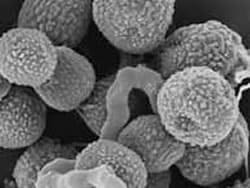What Is Toxic Mold?

The term mold is the common name that refers to any growing fungus. This includes fungi such as mushrooms and yeasts. When found on clothing or other household goods, it is often referred to as mildew.
Image: Mold spores
Molds produce tiny spores to reproduce. Mold spores waft through the indoor and outdoor air continually. When mold spores land on a damp spot indoors, they may begin growing and digesting whatever they are growing on in order to survive. There are molds that can grow on wood, paper, carpet, and foods.
Molds are everywhere in nature, but mold spores in your home, a common component of household dust, can make you, your family members, and/or your pets very sick. And because mold is so common, and the spores are too small to be seen with the naked eye, they are often missed when you and your doctor search for the cause of illness.
Molds typically grow in buildings affected by water damage and have been found in homes, hospitals, schools, and office buildings. It is estimated that about 50 to l00 common indoor mold types have the potential for creating health problems. Exposure to mold has been identified as a potential cause of many health problems including asthma, sinusitis, and infections. It is also believed that molds play a major role in cases of sick building syndrome and related illnesses.
Mold colors may be white, gray, black, brown, yellow or greenish, or a combination of these. Colonies of mold may appear cottony, velvety, granular, leathery and glassy.
“Toxic Mold” is often used to refer to these indoor air quality problems caused by mold spores. Mold-related illness can strike anyone, but at particularly high risk are:
Infants
Pregnant women
Elderly people
Asthma suffers
Diabetics
Those who already have respiratory disorders
People with disorders which compromise the immune system
Some Common Mold-Related Symptoms:
Allergic reactions
Asthma attacks
Increased susceptibility to colds and flu
Sinus infections
Under the right conditions, some species of molds generate molecular compounds called mycotoxins. In large quantities or with chronic exposure, mycotoxins can be toxic to humans or animals, causing allergies or even death. We will discuss this in detain on later pages…
Next : History of Mold and Man

